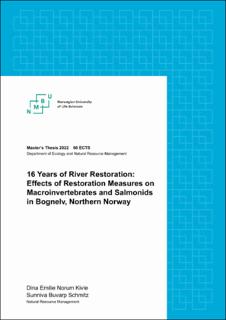| dc.contributor.advisor | Haugen, Thrond Oddvar | |
| dc.contributor.advisor | Colman, Jonathan Edward | |
| dc.contributor.author | Kivle, Dina Emilie Norum | |
| dc.contributor.author | Schmitz, Sunniva Buvarp | |
| dc.coverage.spatial | Norway, Finnmark, Alta, Bognelv | en_US |
| dc.date.accessioned | 2022-07-13T11:08:14Z | |
| dc.date.available | 2022-07-13T11:08:14Z | |
| dc.date.issued | 2022 | |
| dc.identifier.uri | https://hdl.handle.net/11250/3005030 | |
| dc.description.abstract | Lotic ecosystems worldwide are being degraded by human activities, with severe consequences for stream biota. River restoration has gained momentum over the last decade, but many projects lack the long-term monitoring needed to efficiently evaluate restoration outcomes.
One river restoration project operating with a long-term perspective is the project in Bognelv in northern Norway. The river was channelized and secured against erosion and flooding between 1930 and 1990, with a resulting decline in fish stocks of Atlantic salmon (Salmo salar), brown trout (Salmo trutta) and Arctic charr (Salvelinus alpinus). Restoration began in 2006 and is now going on its 16th year, the latest measures being conducted in 2019.
This thesis is the eighth study investigating effects of river restoration on stream biota in Bognelv. Earlier studies show that Atlantic salmon and brown trout have responded well to the restoration measures, while Arctic charr have been absent from studies since 2013. Macroinvertebrates have been sampled in 2015, 2019 and 2021, to better understand how the restoration process affects the river biota.
In August and September 2021, we registered environmental variables and conducted electrofishing and kick-sampling in Bognelv. We followed the study design of earlier studies with a total of 56 stations spread from the lower to the middle stretches of the river. Our analysis focused on three main effects; type of restoration measure, time since last restoration measure, and distance from estuary. Only one Atlantic salmon was caught during electrofishing, and was therefore excluded from analysis. Due to unusual small body sizes and the resulting impaired catchability, 0+ for brown trout were difficult to sample in 2021 and were also excluded from our analyses. Our results show a sharp decline in brown trout densities from previous years for the age classes included in our analyses, but an increase in macroinvertebrate abundance.
The effect of type of restoration measure on macroinvertebrate diversity was not statistically significant, but our results showed a tendency to favor weirs as the most successful measure. We found a significantly positive effect of side channels and channelized stations on macroinvertebrate abundance. We were not able to find a statistically significant effect of type of measure on brown trout densities, but AIC model selection favored weirs and riparian modifications as the most successful measure.
The effect of time since last restoration measure on macroinvertebrates yielded statistically significant effects on abundance, but not on diversity. AIC model selection predicted a peak in abundance eight to ten years post-restoration. The effect of time on brown trout densities showed a decrease in the density the first ten years post-restoration, and a possible bottom- point being reached at about 14 years post-restoration.
The effect of distance from estuary did not prove statistically significant for diversity or abundance of macroinvertebrates. However, combined with type of measure and distance from estuary, the effect on macroinvertebrate abundance was significant. AIC model selection predicted a peak in abundance at three to four kilometers upstream in the river. For brown trout, predicted density was highest close to estuary.
Combined with results from earlier studies on restoration effects in Bognelv, this study provides valuable knowledge for future river restoration projects, as well as for the continued implementation of measures in Bognelv. Even so, more research on the effects of river biota in Bognelv is needed to properly understand the processes at play, and to further improve the ecological condition in the river. | en_US |
| dc.description.abstract | Elvesystemer over hele verden er forringet av menneskelige aktiviteter, med alvorlige konsekvenser for elvebiotaen. Til tross for stort fokus på elverestaurering i løpet av de siste tiårene, mangler mange prosjekter den langsiktige overvåkningen som er nødvendig for å evaluere effektene av restaureringstiltakene. I Bognelv i Nord-Norge pågår det et restaureringsprosjekt med langsiktig overvåkning. Mellom 1930 og 1990 ble elva kanalisert og sikret mot erosjon og flom, med en påfølgende nedgang i fiskebestandene av atlantisk laks (Salmo salar), sjøørret (Salmo trutta) og sjørøye (Salvelinus alpinus). I 2006 startet restaureringen av Bognelv og den har nå pågått i 16 år. De siste tiltakene ble utført i 2019.
Denne oppgaven er den åttende studien som undersøker effektene av elverestaurering på bunndyr og fisk i Bognelv. Tidligere studier viser at atlantisk laks og sjøørret har respondert godt på restaureringstiltakene, mens sjørøye ikke har vært fanget i Bognelv siden 2013. I 2015, 2019 og 2021 har bunndyr blitt innsamlet for å få en bedre forståelse av hvordan restaureringen har påvirket elvebiotaen. I august og september 2021 registrerte vi miljøvariabler, elfisket og tok sparkeprøver av bunndyr i Bognelv. Vi fulgte samme studiedesign som tidligere studier har brukt, med totalt 56 stasjoner spredt fra utløpet til midtre strekninger av elva. Vår analyse fokuserte på tre hovedeffekter: type restaureringstiltak, tid siden forrige restaureringstiltak, og avstanden fra elvemunningen. Atlantisk laks er ekskludert fra analysen vår, ettersom vi kun fikk én atlantisk laks under feltarbeidet vårt. Vi ekskluderte også 0+ sjøørret fra våre analyser, grunnet uvanlig små fiskestørrelser som påvirket fangbarheten. Våre resultater viser en kraftig nedgang i ørrettettheter sammenlignet med tidligere år, men en økning i forekomst av bunndyr. | en_US |
| dc.language.iso | eng | en_US |
| dc.publisher | Norwegian University of Life Sciences, Ås | en_US |
| dc.rights | Attribution-NonCommercial-NoDerivatives 4.0 Internasjonal | * |
| dc.rights.uri | http://creativecommons.org/licenses/by-nc-nd/4.0/deed.no | * |
| dc.title | 16 years of river restoration : effects of restoration measures on macroinvertebrates and salmonids in Bognelv, Northern Norway | en_US |
| dc.type | Master thesis | en_US |
| dc.description.localcode | M-NF | en_US |

